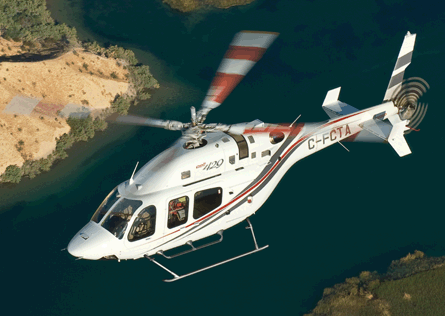Global travel is not generally a flight plan option for a light-twin helicopter, but the Bell 429 is not a typical rotorcraft. Bell president and chief executive John Garrison is here at Farnborough to make that point, among others.
"It's been in Asia, Singapore, India, Japan. We had it at the FIDAE show in Chile in March," says Garrison of the 429's ongoing world tour following US, Canadian and European certification in 2009. Powered by twin Pratt & Whitney Canada PW207D1 engines, each producing 598shp (445kW), the 429 is certificated as European Aviation Safety Agency JAR Ops class one performance at maximum take-off weight, meaning it can return to its landing site or continue a flight after suffering an engine failure.
Most recently a demonstrator, complete with Bell crew, was in Europe, starting in Prague and stopping in Germany, Denmark, Austria and Switzerland. The twin will continue to tour in Europe after its stop at the static display here at Farnborough.
 |
|---|
© Bell Helicopter |
"The response that we've had has been outstanding in terms of capabilities, particularly the demonstrations at altitude in Switzerland," says Garrison, adding, "we're creating interest, which will ultimately turn to orders. Europe, especially western Europe, clearly has gone to the light twin market. The 429 gives us the opportunity to go into Europe and compete effectively."
The regional tours are part of a broader Bell strategy for Europe, the second largest market after the USA. "We're on a mission to enable our customers to be successful," says Garrison. "We've taken definitive steps to improve position here."
Most recently, Bell bought Prague-based Aviation Services, a location that will initially perform modifications and upgrades on Bell helicopters. "We believe it can eventually become a completion centre for us in Europe," says Garrison, taking green aircraft from the USA and fitting custom interiors. That work today is largely done by third-party providers in Europe.
Bell in March hired Larry Roberts, formerly the vice-president of sales, marketing and customer support for American Eurocopter, to head its commercial business arm. "Larry will see us compete effectively across the globe," says Garrison.
Garrison himself is a relative newcomer to the helicopter business. He was named Bell Helicopter president and chief executive in August 2009 after being with the company seven years, most recently serving as president of Textron's Industrial segment, which comprises four businesses: E-Z-GO, Greenlee, Jacobsen and Kautex.
Completions competition will no doubt be fierce as there are many third party companies vying for the limited number of work with new helicopters. "Overall the commercial marketplace has been a challenge," Garrison says. "We saw more cancellations than orders in 2009". The trend has reversed this year but the market remains a challenge. "People are forecasting a trough in 2011 and growth in 2012," says Garrison. "We think with the Bell 429 we can counter some of that."
Bell parent Textron in its first-quarter earnings report said it was on track for 150 commercial helicopter deliveries this year, 25 of which will be Bell 429s. Flight's HeliCAS database records that Bell delivered 142 commercial helicopters in 2009. For the military, Bell plans to deliver 28 V-22s and 20 UH-1 helicopters, up from 20 V-22s and nine UH-1s last year.
Garrison says the V-22, in service with the US Marines and the Air Force special forces, is "performing incredibly well, dramatically improving capabilities for the marine corps". He says the V-22 fleet now has more than 80,000 flight hours, 50% in the past 24 months. "We continue to learn a great deal about the aircraft and customers continue making improvements," says Garrison.
Partnered Boeing, Bell has also submitted the V-22 as a contender for the US presidential helicopter VXX competition.
Bell also continues to actively work in research and development. Textron chief Scott Donnelly recently made comments that Bell would boost research by 50%, introducing product upgrades and possibly new aircraft in 2010.
Garrison was not quite as revealing in his comments. "On the new product side, we will take the approach of working with customers on new product needs," he says. "We are working on things, but are also focused on customer service and support and growing our aviation services business." On tap for the Bell 429 are upgrades in terms of noise and performance, he adds.
Garrison did not have a definitive position on what Bell has decided to do with its partnership with AgustaWestland on the BA609 commercial tiltrotor. AgustaWestland had reported that it was interested in taking full control of the project, and had said in February that it would decide by the end of June. "We continue to evaluate the best way to ensure success of the programme," says Garrison, noting that there are still two prototypes flying, one in the USA and one in Italy, but that no date has been set for certification.
Of his first year on the job with Bell, Garrison says: "It's been a great experience."
"I'm personally thrilled, honoured and humbled to be working at a company like Bell. This industry has tremendous potential."
- All the latest news, video and images from the 2010 Farnborough air show - New this year, live streaming video of each day's flying display
Source: Flight Daily News























